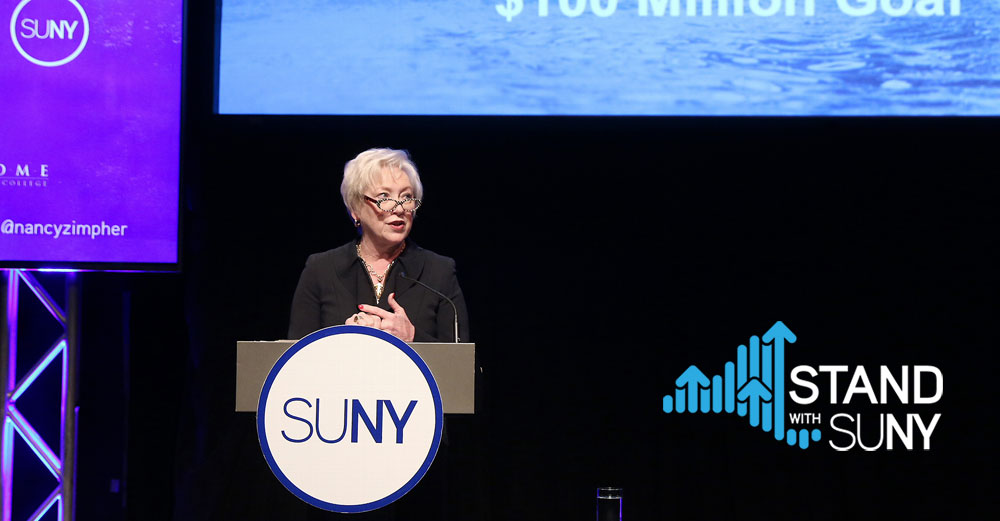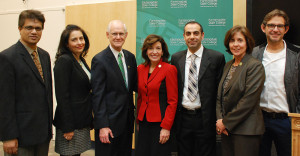
In his budget, Gov. Andrew Cuomo extended a very important program to SUNY, NYSUNY 2020. This legislation is crucial to the University, and I want to be sure we do our best job explaining NYSUNY 2020, and how and why it works.
There are two core purposes of this critical legislation. One, to protect SUNY students from unpredictable changes in tuition, and two, to provide reliable funding that SUNY can count on so we can provide the world-class education New Yorkers need and deserve.
Until NYSUNY 2020, tuition-setting power was in the hands of the state Legislature, not SUNY. Some years there were no changes at all, but others had unpredictable spikes. The smallest increase was 14 percent (2009-2010), and the highest was a staggering 30 percent (1991-1992) in a single year. To make matters worse, the revenue generated by these hikes only made up for drastic reductions in direct state tax support, closing other budget gaps that had nothing to do with SUNY.
NYSUNY 2020 fixed this situation. Now SUNY controls changes in tuition, and we set a $300 cap on how much it can change in a year. We know that $300 is not nothing. We know families feel that. But we also know that this is a comparatively incremental change — incremental compared to years past when the legislature dealt sporadic hikes and compared to other public university systems and their costs and tuition policies that do not have the predictability of SUNY’s.
Under NYSUNY 2020, SUNY remains the least expensive higher education deal in the northeast and is among the most affordable in the United States. Less expensive than Pennsylvania, Michigan, Massachusetts, Virginia, Ohio, California, and Texas systems. These are the states with the best rated public university systems in the U.S., and SUNY is among them — but less expensive. And under the protections of NYSUNY 2020, we will continue to be so.
Let me be absolutely clear: A reenactment of NYSUNY 2020 is not an automatic renewal of annual tuition hikes. It is a renewal of SUNY’s ability to set tuition based on the immediate needs of SUNY’s state-operated campuses and the students, faculty and staff they serve. It is also a renewal of our commitment to the state’s lowest income, TAP-eligible students and our ability to cover them tuition free. Nearly a third of new resident undergraduate tuition revenue goes to ensure the state’s highest need students are completely covered. NYSUNY 2020 has the support of our Student Assembly. We could not, and would not, have done this without them.
Within just a few years from now, 70 percent of jobs in New York state will require a college degree or credential. Right now, 45 percent of New Yorkers have a college degree. There’s a big gap there.
Our NYSUNY 2020-enabled policies allow us to take the revenue that comes from any tuition change and put it right back into student services and campuses. We hired more faculty. We are perfecting the transfer process so students don’t lose a dime of their hard-earned money and finish on time. We’ve built the world’s largest online learning consortium to expand student access and flexibility. At SUNY, we are a thousand percent dedicated to — frankly, we are obsessed with — making sure every single degree earned prepares our graduates for the world and workforce in the 21st century.
Yes, the higher education chairs in the Senate and Assembly are correct: SUNY needs more direct support from the state. If the past five years have shown any shortfalls of NYSUNY 2020, it’s that the state’s maintenance of effort clause should be strengthened. Flat funding year-to-year is simply not enough, especially alongside increased student investment.
We appreciate the additional dollars provided by the governor in his budget, and we will continue to engage our elected leaders to secure the more robust base support we need to make SUNY great, to make it the best. Because that’s what we’re striving for. New Yorkers deserve no less. Let’s not throw away the investment and long-overdue reforms we’ve made over the last five years.
Read this in Poughkeepsie Journal or Binghamton Press & Sun Bulletin



